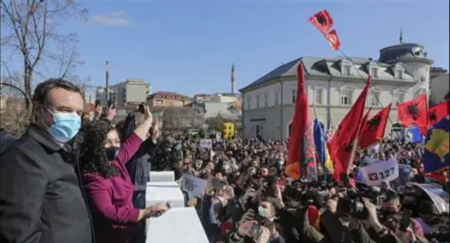 Bertil Lintner: MYANMAR’S military leader, Senior General Min Aung Hlaing, had probably not intended or expected to change the geopolitics of Southeast Asia when he staged an ill-timed and unwelcome coup in February 2021. By overthrowing a mostly democratically elected government, he managed to antagonize the West, which had hailed what it called “a democratic transition” in Myanmar. When a former general, Thein Sein, formed a new government in March 2011 following elections in November 2010, a number of breathtaking initiatives were taken. Political prisoners were released, and the previously heavily censored press began to enjoy unprecedented freedoms. Political parties were allowed to function, and although the 2010 election had been blatantly rigged in favor of Thein Sein and the military’s Union Solidarity and Development Party (USDP), a surprisingly free election was held in 2015, which led to the formation of a government led by the National League for Democracy (NLD). The West was overjoyed, and Myanmar turned from being an international pariah to becoming the darling of the United States and other democratic countries. US President Barack Obama visited Myanmar, as did other Western dignitaries from British Prime Minister David Cameron to the King of Norway. Aung San Suu Kyi was a global celebrity.
Bertil Lintner: MYANMAR’S military leader, Senior General Min Aung Hlaing, had probably not intended or expected to change the geopolitics of Southeast Asia when he staged an ill-timed and unwelcome coup in February 2021. By overthrowing a mostly democratically elected government, he managed to antagonize the West, which had hailed what it called “a democratic transition” in Myanmar. When a former general, Thein Sein, formed a new government in March 2011 following elections in November 2010, a number of breathtaking initiatives were taken. Political prisoners were released, and the previously heavily censored press began to enjoy unprecedented freedoms. Political parties were allowed to function, and although the 2010 election had been blatantly rigged in favor of Thein Sein and the military’s Union Solidarity and Development Party (USDP), a surprisingly free election was held in 2015, which led to the formation of a government led by the National League for Democracy (NLD). The West was overjoyed, and Myanmar turned from being an international pariah to becoming the darling of the United States and other democratic countries. US President Barack Obama visited Myanmar, as did other Western dignitaries from British Prime Minister David Cameron to the King of Norway. Aung San Suu Kyi was a global celebrity.
But when the NLD won a second landslide victory in November 2020, the military had had enough. A coup was staged, and the NLD president, Win Myint, state counselor Aung San Suu Kyi and hundreds of MPs and others from the pro-democracy forces were arrested.
The problem all along was that the “transition” was not what it seemed. Western sanctions and boycotts had forced the ruling military to rely on China for trade, diplomatic support and arms deliveries. According to classified Myanmar military documents seen by this writer, the situation had become so grave that the generals believed Myanmar was in danger of losing its sovereignty to China. In order to become more acceptable to the broader international community, it was deemed necessary to make certain changes. The generals could afford the risk because the country’s new constitution, which had been promulgated after a fraudulent referendum in 2008, safeguarded the supreme power of the military even if the old, strict dictatorship was modified and some civilians became ministers in a future government. The three most important ministries — defense, border affairs and interior, which controls the police and other security services — would be under the military, not the elected government. The armed forces would also be autonomous and take orders only from the Supreme Commander. And the military has said time and again, before as well as after the coup, that it is their duty to defend that constitution. No changes would be tolerated; that was also enshrined in the 2008 constitution. The military would appoint a quarter of all seats in the Union Parliament, and in order to amend the constitution, more than three-quarters of parliament members would have to vote in favor.
What happened during the decade 2011-2021 was not a transition to any fundamentally new political system, but the introduction of an indirect and more liberal form of military rule, which could not be altered by civilians. The military even claims that the 2021 coup was not a coup but a constitutional change of government. The 2008 constitution gives the president the authority to hand over power to the military in case of an emergency. Win Myint steadfastly refused to do so, but that did not stop the military. Win Myint was unceremoniously replaced by the vice president, the military-appointed general Myint Swe, who became “acting president.” Most Western nations quickly condemned the coup and downgraded their relations with Myanmar. But the coup provided China with an excellent opportunity to reestablish its partly lost influence in Myanmar.
STRATEGIC POSITION
It is enough to look at a map of Asia to realize how strategically important Myanmar is to Beijing, and why China cannot let go of its weak, southern neighbor. China is a huge inland empire with a comparatively short coastline. For a country with a growth model based on exports, access to ports is vital. Myanmar is a crucial link in Beijing’s foreign policy because it is the only neighboring country — apart from remote and crisis-ridden Pakistan and, to some extent, Sri Lanka — that provides China with direct access to the Indian Ocean, and thus makes it possible to bypass the contested South China Sea and the congested and potentially vulnerable Strait of Malacca for exports as well as the import of gas, oil and minerals. In fact, the importance of Myanmar as an outlet to the Indian Ocean was first outlined by Pan Qi, a former minister, as far back as Sept. 2, 1985, in an article in the Beijing Review. Now called the China Myanmar Economic Corridor (CMEC), it is meant to provide China with an outlet for exports to Myanmar and, even more important, beyond. The route broadly follows gas and oil pipelines from the Myanmar coast to Yunnan, which were built in 2013 and 2017. Plans are also under way for high-speed rail links between Yunnan and Kyaukphyu, a deep-water port on the Bay of Bengal, which also has a 1,600-hectare special economic zone for foreign trade.
However, China’s Myanmar policies have not been without problems. It may seem understandable that China would like to provide such important trade links with a defense umbrella, which would have to be through support for a loyal Myanmar dependent on China for arms, training and other military co-operation. In the decade after the nationwide uprising for democracy in 1988 that was brutally crushed, Myanmar became isolated internationally and its military had to turn to China for military hardware. In the decade after the 1988 massacres, when few other countries would provide the murderous regime with any kind of weaponry, China sold more than US$1.4 billion worth of aircraft, naval vessels, heavy artillery, antiaircraft guns and tanks to Myanmar. China also helped Myanmar upgrade its naval bases along the coast and on islands in the Bay of Bengal and the Andaman Sea. Chinese-supplied radar systems were installed in some of these bases, and it is reasonable to assume that China’s security services benefited from the resulting intelligence.
To lessen the dependence on China, the Myanmar military began to cultivate defense ties with Russia, which sold its first consignment of MiG-29 jets to Myanmar in 2001. That sale was followed by another 10 MiGs in 2002. In 2006, the state-owned Russian Aircraft Corporation MiG, now restructured as the United Aircraft Corporation, opened an office in Yangon. The Myanmar Air Force has also acquired at least nine Russian-made Mi-35 Hind helicopter gunships as well as 12 Mi-17 helicopters. Russia has also sold heavy machine-guns and rocket launchers to Myanmar, and, before the Ukraine war, Russian-made tanks and armored personnel carriers were obtained through dealers in Kyiv. According to eyewitnesses, Russian military instructors have been spotted at Myanmar airfields, presumably to assist in maintenance of the attack helicopters. But such training is not new; probably as many as 5,000 Myanmar soldiers and scientists have studied in Russia since the early 1990s, more than from any other Southeast Asian country. In 2007, Russia signed an agreement to build a nuclear research reactor in Myanmar, but construction was delayed, and for a while it seemed that the project was not going to materialize. Then, on Feb. 6 this year, Rosatom, a Russian state-owned corporation that specializes in nuclear energy, issued a statement saying that its director, “General Alexey Likhachev and the Union Minister for Science and Technology Dr. Myo Thein Kyaw signed the Intergovernmental Agreement on co-operation in the field of the use of nuclear energy for peaceful purposes. The signing ceremony took place in the presence of the Chairman of the State Administration Council, Prime Minister of Myanmar, Senior General Min Aung Hlaing.” Russian support for the Myanmar junta, formally called the State Administration Council, could not have been made clearer. Ties with Russia are close even at political party levels. On Feb. 20, Khin Yi, the chairperson of the military proxy party USDP, met with Russia’s ambassador to Myanmar, Nikolay Listopadov. After the meeting, Khin Yi announced on his Facebook page that they “discussed increased co-operation between Myanmar and Russia,” and mentioned “the future young generation,” presumably a reference to educational opportunities for Myanmar citizens in Russia. Moscow’s interests in Myanmar may be motivated primarily by a desire to earn money, but it can also be seen as part of an attempt to restore Russia’s position as a world power after the collapse of the Soviet Union in 1991 and which Vladimir Putin now is trying to regain through the war against Ukraine and diplomatic maneuvers in Asia and Africa. At the same time, it remains an open question how much military equipment Russia, after suffering heavy losses in Ukraine, can actually sell to Myanmar in the future.
Nevertheless, the United States reacted immediately when the nuclear deal was announced. The US State Department said in an e-mailed statement to Voice of America that “we are deeply concerned with — but not surprised by — Russia’s willingness to expand its material support, including through nuclear energy co-operation, to the repressive regime in Burma (Myanmar). Russia’s actions are prolonging a crisis that threatens our efforts to advance peace and prosperity with our partners and allies in the Indo-Pacific.”
ASEAN NON-STARTER
But preoccupied with Ukraine, Myanmar is not high on Washington’s list of security priorities. As reflected in an official State Department statement issued jointly with a series of nations on Jan. 31, the second anniversary of the coup, Washington appears to have outsourced the Myanmar issue to the Association of Southeast Asian Nations: “We welcome and support the central role of ASEAN in addressing the crisis in Myanmar,” support the efforts to “fully implement ASEAN’s Five-Point Consensus” and reaffirm “support for the ASEAN Special Envoy to Myanmar and the UN Special Envoy to Myanmar.”
The problem is that ASEAN’s “five-point consensus,” which was adopted in Jakarta on April 24, 2021, and which calls for “an immediate end to violence in the country; dialogue among all parties; the appointment of a special envoy; humanitarian assistance by ASEAN; and the special envoy’s visit to Myanmar to meet with all parties,” has been an abysmal failure. Human Rights Watch stated on April 22, 2022: “Two days after the consensus agreement, the junta walked back its endorsement, announcing it would consider the “suggestions made by ASEAN leaders when the situation returns to stability.”
Rather than halting attacks, as called for by its fellow ASEAN members, the junta ramped up its abuses. “Junta violations since the coup include mass killings, torture, arbitrary arrests, and indiscriminate attacks on civilians that amount to crimes against humanity and war crimes,” according to Human Rights Watch. ASEAN is guided by two main principals, consensus and non-interference, which means that it cannot do anything constructive to solve the crisis in Myanmar. It is also almost always forgotten that ASEAN is a gathering of 10 mostly non-democratic regimes that would not necessarily be interested in a free and democratic Myanmar. Indonesia, this year’s chair, may be a rare democratic exception, but there is little adherence to democratic values in most other ASEAN countries.
India, Myanmar’s western neighbor and China’s main strategic rival in the region, has tried to counter Beijing’s influence and has sold radar technologies and remote air defense systems to Myanmar since the coup. New Delhi’s main concern is the access that China has gained to the Bay of Bengal, which is perceived as a direct threat to India’s security. But those sales and other exchanges between Myanmar and India are unlikely to rock China’s efforts to bring Myanmar back into its orbit, as are efforts by the Japanese Nippon Foundation to mediate in Myanmar’s civil wars. Its local representative, Yohei Sasakawa, has been seen meeting Min Aung Hlaing and some representatives of Myanmar’s ethnic armed resistance groups. But his influence is at best limited and certainly frowned upon by Chinese leaders who remember the role his stepfather, Ryoichi Sasakawa, played in China during the Sino-Japanese war in the 1930s. Sasakawa was imprisoned as a war crimes suspect by the Allies after the end of the Second World War, but released in 1948.
RESURGENT CHINA
Russia’s, India’s and Japan’s limited resources, inactivity on the part of ASEAN and the West’s preoccupation with global security issues elsewhere have left Myanmar open to renewed Chinese penetration. The Myanmar military may be reluctant to once again become dependent on Chinese arms supplies, but China has since the coup supplied Myanmar with sophisticated electronic surveillance systems, which the generals would have difficulty obtaining elsewhere, including cameras equipped with facial-recognition and license-plate recognition technology. Such sales increased dramatically in 2022, according to industry sources, and the Chinese suppliers have in some instances stripped the equipment of visible branding to obscure the maker and the origin, which could complicate the businesses those companies have in the US and European Union, where strict sanctions apply on entities dealing with the Myanmar junta.
At the same time, China is the only outside power that has close relations with Myanmar’s strongest ethnic armed resistance groups. In late February, Deng Xijun, China’s special envoy to Myanmar, held meetings in the border areas with representatives from the Kachin Independence Army, the United Wa State Army and the National Democratic Alliance Army in Shan State. On Feb. 27, a Shan website quoted a local analyst as saying that the reason for the meeting was to express China’s concerns over the opening of an office in Washington for Myanmar’s National Unity Government (NUG), which is made up of former members of parliament and pro-democracy activists, and to presumably warn those ethnic armies not to have close contacts with the obviously pro-Western NUG. China may be close to the Myanmar junta, but several of the ethnic armies are also equipped with weapons obtained from Chinese suppliers. Indeed, a certain degree of continued instability in Myanmar’s frontier areas is in China’s interests because it can keep the country weak and vulnerable, and makes it possible to play all sides in tandem with official, diplomatic niceties about “friendship” and “non-interference.” As a long-time observer of Myanmar politics put it: “It looks to me as if the Chinese are working, as they often do, to keep a foot of some sort in all camps.”
China’s interests are long-term with the China Myanmar Economic Corridor, and access to the Indian Ocean is the central theme. The Chinese are playing many cards to outmaneuver possible rivals in Myanmar, and there is precious little that the outside world can do about it — unless there is a sudden and dramatic change inside Myanmar, which would have to come from within the military. But there have so far been no signs of divisions in the armed forces.
Since the coup, the geopolitical balance has tilted to the advantage of China, and whether that was Min Aung Hlaing’s intention when he sent his tanks into Yangon and the new capital Naypyidaw, it is the reality of his ill-thought-out action two years ago. Myanmar is back to square one as an international pariah — and a country that that will find it hard to resist the advances of its powerful northern neighbor. (GA)
iNews covers the latest and most impactful stories across
entertainment,
business,
sports,
politics, and
technology,
from AI breakthroughs to major global developments. Stay updated with the trends shaping our world. For news tips, editorial feedback, or professional inquiries, please email us at
[email protected].
Get the latest news and Breaking News first by following us on
Google News,
Twitter,
Facebook,
Telegram
, and subscribe to our
YouTube channel.



